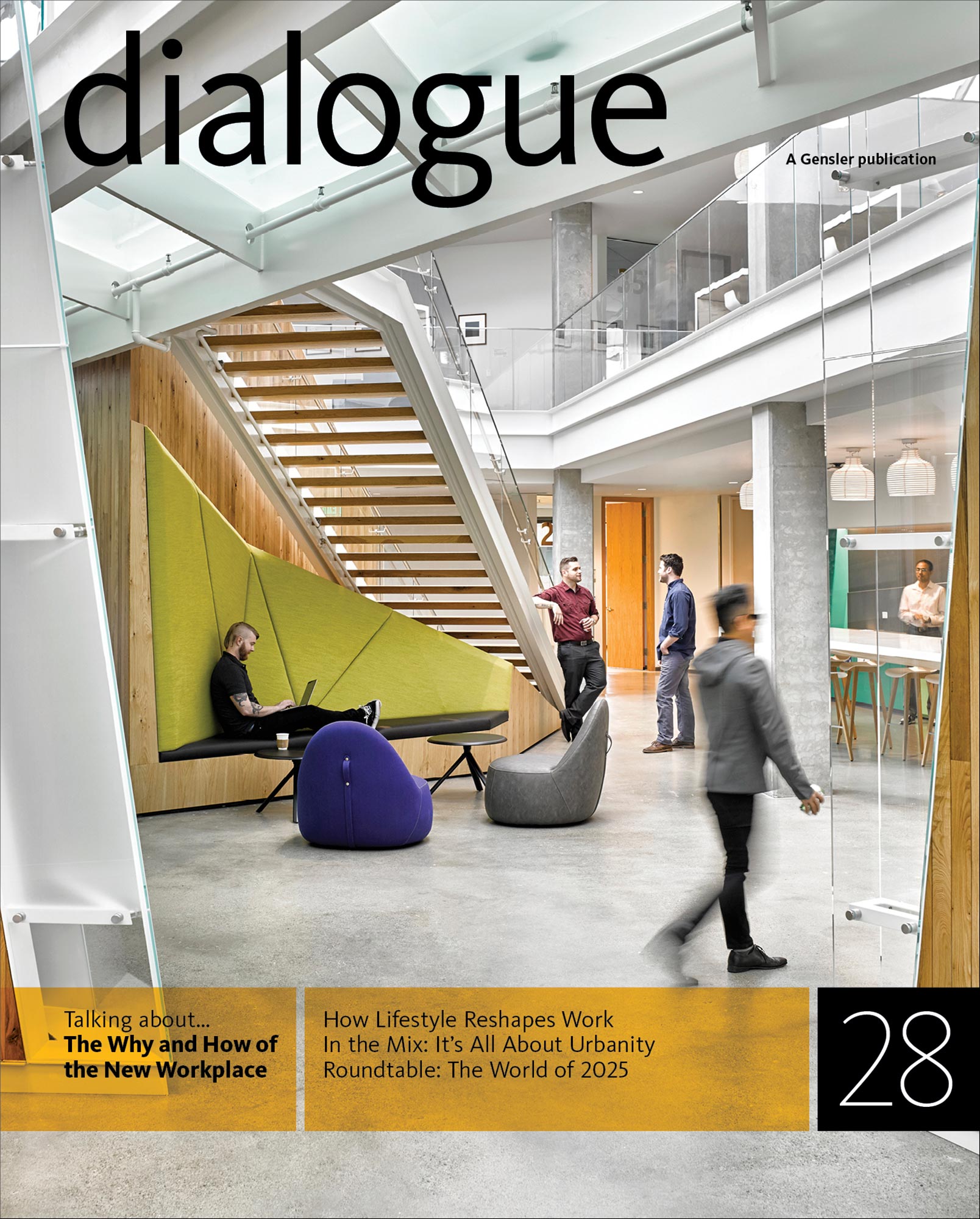Finding Your Balance
Workplace strategy seeks to increase collaboration and real estate efficiency. The risk is distraction, which can undermine focus work and collaboration. A Gensler research team made a deep dive into this dilemma. Here’s what they learned.
Gensler made headline news when its most recent US Workplace Survey uncovered the central importance of focus to effective performance. The 2013 survey found that when people are distracted in the workspace, their ability to focus and to collaborate is undermined. This finding gave ammunition to the critics of dense, open-plan work settings.
“Whenever I spoke about the workplace, I asked people how many could put aside an hour for heads-down, concentrated work in their workday. I only saw a few hands,” says Gensler’s Gervais Tompkin. His informal confirmation of the 2013 survey’s headline finding led him to ponder, “How can people successfully execute their individual focus work in a workplace that emphasizes collaboration?”
A deep dive into tech
To answer the question, Tompkin and his Gensler colleagues Laura Mihailoff, Thomas Muchnick, and Lisa Hsiao joined forces with researchers at a global tech firm to study its software developers and engineers—people whose complex work requires a lot of focus.
Developing software is increasingly collaborative: self-organizing, cross-functional teams move through a series of fast development cycles. This “agile” method of working breaks tasks into small increments that last from one to four weeks. The work varies between periods of intense focus and intense collaboration. The research team’s interviews and surveys showed that about 70 percent of a developer’s time went into individual focus work. Some of it is casual and interruptible, like doing email and instant messaging; other tasks—like coding, testing, and debugging—can only be interrupted at the cost of the developer’s productivity. Yet ad hoc conversations and brainstorming sessions are part of how a developer team makes progress.
“There’s a lot of money to be made, the competition is fierce, and speed to market is essential,” Tompkin says. “Software development is schedule-driven: ‘Just ship it!’” That pressure can exacerbate the problems of an open workplace. Most commonly cited is an inability to focus—the space is too loud and distracting. Yet open-plan offices aren’t going away, not least because they leverage mobility and offer real estate savings.
“People are doing more focus work than ever before, but they don’t feel effective at it,” says Muchnick. “Solving that dilemma is complicated by the organizational need for collaboration: the two work modes are joined at the hip.” For the research team, the ah-ha moment was to realize that an effective workplace has to get both of them right. “It’s not just about the space. People are frustrated with acoustics and density, but they also complain about unproductive meetings. How work happens is as important as where it happens.”
What worked and what didn’t
The tech workplace the researchers studied—a newly occupied “agile” workplace—has a series of open team areas, each with 15 workstations. Support spaces separate each team. In focus groups and interviews, developers and testers said they were more satisfied with their new workplace than other teams were. It fit their team dynamics, culture, and individual work needs, they reported. It was the right size to allow coworkers to sit together, interacting in the midst of intense focus work. Proximity made both kinds of work more productive, in part because it cut back on email and sped up decisions.
But user experience (UX) designers were much less satisfied. They collaborate with multiple teams, but tend to sit with other UX designers, so the proximity the agile workplace provided caused distraction. Interacting episodically with developers and testers, their ties to them were tenuous, giving them less control over where and how they worked within the larger workplace. To cope, they sought out more effective focus spaces elsewhere.
The research suggests that people can perform well, even in highly interactive settings, if they have access to workspaces and processes that enable them to balance collaborative and focus work in real time. Proximity to teammates can inform individual focus work if the people involved are working closely on the same project. For the UX designers, the workplace didn’t match the way they worked. They needed a less intensive collaboration space, with the option of shifting totally into focus mode. Solving their dilemma could involve both changes to the space and changes in work processes and protocols.
On-the-job strategies
A Gensler report on the research, My Work in a We World, points to four strategies for balancing focus and collaboration: choice and control over where work takes place; team discipline; an agreed-upon code of behavior; and decision-making autonomy. These strategies need to be tailored to the organization, the teams, and the work. “More than just the settings, it takes in team dynamics, organizational culture, and work practices and policies,” says Hsiao. Because cognitive style is individualized, exercising choice is critical to people’s sense that they’re working effectively. “It’s best if they can control both their space and their situation,” says Mihailoff.
A balancing act
Gensler’s Janet Pogue, one of the leaders of the firm’s workplace survey research, sees balancing focus and collaboration as an ongoing process: “People navigate it on a daily basis, looking to their teams and organizations to support them. But the context in which they operate can be unsupportive, making balance harder to achieve.”
The deep dive her colleagues made into the tech workplace shows the benefits of providing those supports, she adds. Indeed, a key finding of Gensler’s 2013 survey is that people who experienced this balance gave their organizations high marks for encouraging innovation and creativity. They also reported a higher sense of personal performance and satisfaction. “When collaboration and focus are in sync, individual and team performance soar,” Pogue concludes.
J. Michael Welton writes for the New York Times, the Washington Post, and Dwell.

